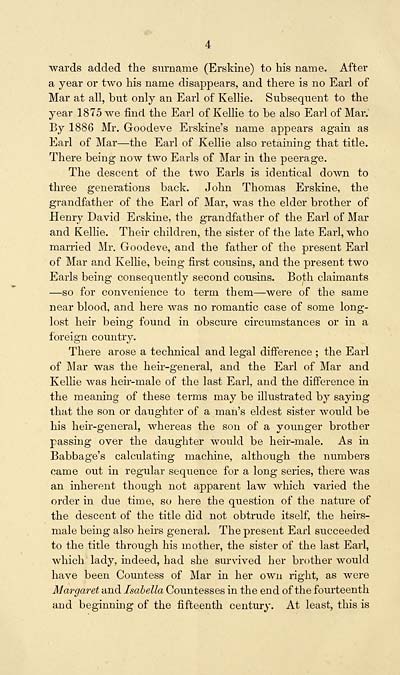Proceedings in the case of Earldom of Mar
(10) Page 4
Download files
Complete book:
Individual page:
Thumbnail gallery: Grid view | List view

wards added the surname (Erskine) to his name. After
a year or two his name disappears, and there is no Earl of
Mar at all, but only an Earl of Kellie. Subsequent to the
year 1875 we find the Earl of Kellie to be also Earl of Mar.
By 1886 Mr. Goodeve Erskine's name appears again as
Earl of Mar — the Earl of Kellie also retaining that title.
There being now two Earls of Mar in the peerage.
The descent of the two Earls is identical down to
three generations back. John Thomas Erskine, the
grandfather of the Earl of Mar, was the elder brother of
Henry David Erskine, the grandfather of the Earl of Mar
and Kellie. Their children, the sister of the late Earl, who
married Mr. Goodeve, and the father of the present Earl
of Mar and Kellie, being first cousins, and the present two
Earls being consequently second cousins. Both claimants
— so for convenience to term them — were of the same
near blood, and here was no romantic case of some long-
lost heir being found in obscure circumstances or in a
foreign country.
There arose a technical and legal difference ; the Earl
of Mar was the heir-general, and the Earl of Mar and
Kellie was heir-male of the last Earl, and the difference in
the meaning of these terms may be illustrated by saying
that the son or daughter of a man's eldest sister would be
his heir-general, whereas the son of a younger brother
passing over the daughter would be heir-male. As in
Babbage's calculating machine, although the numbers
came out in regular sequence for a long series, there was
an inherent though not apparent law which varied the
order in due time, so here the question of the nature of
the descent of the title did not obtrude itself, the heirs-
male being also heirs general. The present Earl succeeded
to the title through his mother, the sister of the last Earl,
which lady, indeed, had she survived her brother would
have been Countess of Mar in her own right, as were
Margaret and Isabella Countesses in the end of the fourteenth
and beginning of the fifteenth century. At least, this is
a year or two his name disappears, and there is no Earl of
Mar at all, but only an Earl of Kellie. Subsequent to the
year 1875 we find the Earl of Kellie to be also Earl of Mar.
By 1886 Mr. Goodeve Erskine's name appears again as
Earl of Mar — the Earl of Kellie also retaining that title.
There being now two Earls of Mar in the peerage.
The descent of the two Earls is identical down to
three generations back. John Thomas Erskine, the
grandfather of the Earl of Mar, was the elder brother of
Henry David Erskine, the grandfather of the Earl of Mar
and Kellie. Their children, the sister of the late Earl, who
married Mr. Goodeve, and the father of the present Earl
of Mar and Kellie, being first cousins, and the present two
Earls being consequently second cousins. Both claimants
— so for convenience to term them — were of the same
near blood, and here was no romantic case of some long-
lost heir being found in obscure circumstances or in a
foreign country.
There arose a technical and legal difference ; the Earl
of Mar was the heir-general, and the Earl of Mar and
Kellie was heir-male of the last Earl, and the difference in
the meaning of these terms may be illustrated by saying
that the son or daughter of a man's eldest sister would be
his heir-general, whereas the son of a younger brother
passing over the daughter would be heir-male. As in
Babbage's calculating machine, although the numbers
came out in regular sequence for a long series, there was
an inherent though not apparent law which varied the
order in due time, so here the question of the nature of
the descent of the title did not obtrude itself, the heirs-
male being also heirs general. The present Earl succeeded
to the title through his mother, the sister of the last Earl,
which lady, indeed, had she survived her brother would
have been Countess of Mar in her own right, as were
Margaret and Isabella Countesses in the end of the fourteenth
and beginning of the fifteenth century. At least, this is
Set display mode to:
![]() Universal Viewer |
Universal Viewer | ![]() Mirador |
Large image | Transcription
Mirador |
Large image | Transcription
Images and transcriptions on this page, including medium image downloads, may be used under the Creative Commons Attribution 4.0 International Licence unless otherwise stated. ![]()
| Histories of Scottish families > Proceedings in the case of Earldom of Mar > (10) Page 4 |
|---|
| Permanent URL | https://digital.nls.uk/95118330 |
|---|
| Description | A selection of almost 400 printed items relating to the history of Scottish families, mostly dating from the 19th and early 20th centuries. Includes memoirs, genealogies and clan histories, with a few produced by emigrant families. The earliest family history goes back to AD 916. |
|---|
![[Page 3]](https://deriv.nls.uk/dcn4/9511/95118320.4.jpg)
